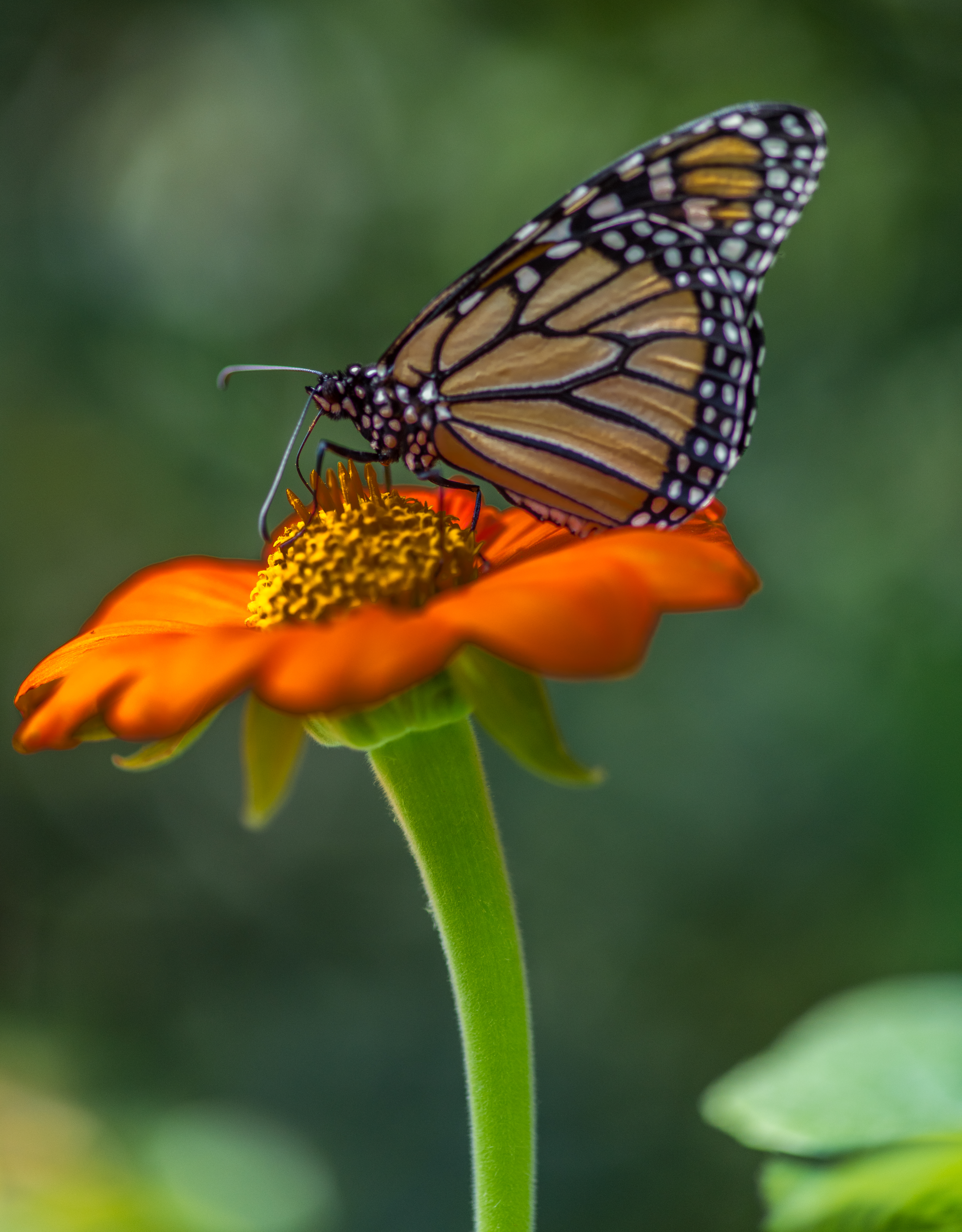The Mysterious Ways of the Monarch Butterfly
Instinct — we’re told to trust ours. In nature, there’s little more powerful than its invisible pull, and few animals are more reliant on it than the monarch butterfly.
From their wingspan to their electric color, monarchs are majestic creatures. It’s easy to forget that before they’re gliding effortlessly through the air, they’re confined to the leaves of a milkweed plant. It’s through listening to their instincts that they undergo that notorious metamorphosis that has inspired famous works of art, music, and theater, and allows them to fly.
“Most butterflies go through several caterpillar stages,” explains Matthew Quenaudon, the integrated pest management specialist at Phipps Conservatory and Botanical Gardens. As an entomologist, Quenaudon works on the annual Butterfly Forest, which returns to Phipps this spring. “To get bigger, most insects have to shed their exoskeleton.” Monarch caterpillars molt five times. Combined, all five stages only take between nine days and two weeks, and, at the end of the fifth stage, the transformation begins.
“When they’re ready, they’ll instinctually cling on to something and start to build their chrysalis.” (Note that a butterfly spends its pupal stage in a chrysalis, not a cocoon. Only moths develop within cocoons, which are differentiated by silken coverings.) Near the end of its eight to 15 days inside, a monarch’s bright orange, black, and white pigmentation begins to develop and become visible through the chrysalis. Shortly thereafter, one of nature’s wildest transformations emerges from within.
“A lot of people think it’s this really beautiful sight, but the butterfly actually doesn’t look super pretty when it comes out,” Quenaudon admits, unabashedly crumbling the image of a miraculous flourish of color and wings. “It’s bloated — its abdomen is really fat and its wings are really small and shriveled. So when they swing out, they use a lot of the blood in their bodies to pump their wings full. That’s why they have to be hanging.” He shrugs, “It is what it is.”
Beautiful or not (we’ll leave it to the eye of the beholder), the exit process completes an inarguably amazing metamorphosis. Fully grown, monarchs begin their adult lives and, like many in the animal kingdom, spend it mating. But unlike many in the animal kingdom, where a monarch repopulates is as mystifying as the metamorphosis itself. Each fall, they migrate across the continent — monarchs west of the Rocky Mountains head toward coastal California, and monarchs east of the Rockies (our monarchs) travel south to Mexico — to spend the winter in a warm, habitable climate.
During our cold months, forests along the west coast of Mexico in the state of Michoacán are ablaze with thousands of monarchs that have made the journey. “They are just huge,” Quenaudon says of the towering trees that are filled with so many butterflies they look like fluttering, orange leaves. The monarchs are dormant until around the beginning of March. But when they start to wake up, “they just know to go.” As they move north towards Pittsburgh, an incredible display of instinct takes over. “The ones that get here in Pennsylvania aren’t the ones that were in Mexico,” Quenaudon explains. “By the time butterflies get to us, it’s about the fourth generation, which is really cool because a lot of people — scientists — are still confused about how they know where to go. It’s instinctual.”
That means three generations of butterflies are born somewhere between the southern and northern border of the United States and instinctually know to continue traveling. While navigating the course, monarchs continue to mate as the females lay eggs, all while cross-pollinating the nectar flowers on which they feed. But monarchs won’t lay their eggs just anywhere — they look exclusively for milkweed plants.
Milkweed is toxic to other animals, keeping the monarchs who feed on it and inhabit it relatively safe from predators. Even though adult monarchs eat nectar plants, the larva only eat milkweed and rely on it to grow. “It’s their host plant,” says Quenaudon, “and you can imagine, if several generations are making their way from Mexico to Pennsylvania, the less milkweed there is, the more dramatic the loss.”

And that’s exactly what is happening. Between habitat destruction and poisonous herbicides, milkweed abundance has severely decreased, particularly in the central United States. Without milkweed, female monarchs fly around, unable to lay their fertilized eggs. And since generations turn over four times in even just one migration north, the population decrease can occur at drastic speeds.
A March 2015 report from Xerces Society and NatureServe, both nonprofit organizations for nature conservation, states that “the eastern monarch population was assessed as ‘critically imperiled’ due to recent rapid decline and widespread threats.” Monarch Watch, a conservation effort based at the University of Kansas, reported that, while the average overwintering site in Mexico was 5.91 hectares (Note: 1 hectare = 100 acres) between 1994 and 2016, the average between 2004 and 2016 was only 3.36 hectares. Meanwhile, the 2013-14 winter was a record low of just 0.67 hectares, but this winter spiked back up to 4.01 hectares, a dramatic increase, yet still a low average.
The reduced acreage is representative of population loss during the long spring migration, and likely due, at least in part, to diminishing milkweed. As natural pollinators, monarchs (and all butterflies) carry pollen from one flower to another as they feed on nectar. In fact, butterflies are some of the only insects that can pollinate native North American flowers — the vast majority of honey bees were imported from Europe by colonists and do not have the proper tools to pollinate them. Even further, the great migrating distances of monarchs in particular provide a crucial expanse that other species simply cannot cover. “Butterflies are vital to pollination — just like moths, flies, bees, and other insects,” provides Theresa Coleman, display horticulturist at Phipps. “Without them, some plants would disappear forever.”
Per their migratory patterns, monarchs should start appearing in Pittsburgh in early May. As harbingers of warm weather, the butterflies will reach us as the days begin to extend into night, and their instincts drive them north in search of the very host plants that are becoming harder to find. But with some effort on our part, as the most recent overwintering count has established, we can continue to watch as these marvelous animals carry out their awe-inspiring lives.
For more information and to join the conservation effort, visit Xerces Society for Invertebrate Conservation at xerces.org, NatureServe at natureserve.org, or Monarch Watch at monarchwatch.org.
Get Up Close at Phipps’ Butterfly Forest
On April 22, the Butterfly Forest at Phipps Conservatory and Botanical Gardens will officially open! Watch as butterflies swarm around you (and maybe even on you!) in this beautiful show. Plus, Phipps will formally welcome their winged guests on May 19 with Bowties & Butterflies, a ticketed garden gala. And monarchs won’t be the only butterflies in flight!
The forest will also include:
Zebra Longwing • Julia Longwing • Painted Lady • Southern White • Queen • Florida Malachite • Black Swallowtail • Gulf Fritillary • Buckeye • Tiger Swallowtail • Pipevine Swallowtail • Red-Spotted Purple • Question Mark • Red Admiral • Spicebush Swallowtail • White Peacock • Great Southern White • Orange Barred Sulphur • Cloudless Sulphur • Polydamas Swallowtail
>> For more information, visit phipps.conservatory.org.
Planting Milkweed
One reason that milkweed growth has declined is because of its undeserved bad rap; “weed” in a name isn’t typically a go-to while choosing plants. However, milkweed — in all of its many varieties — can make a really beautiful addition to any garden. Try adding some to your own!
1. Look for its scientific name, Asclepias, when shopping for milkweed. Many brands shy away from the unappealing stereotype of a weed.
2. Stay local! Here are some types that can be found naturally in South Western Pennsylvania:
• Butterfly Milkweed, Asclepias tuberosa
• Swamp Milkweed, Asclepias incarnata
• Common Milkweed, Asclepias syriaca
• Purple Milkweed, Asclepias purpurascens
• Poke Milkweed, Asclepias exaltata
3. Milkweed seedlings can be started indoors then transported outside after last frost. Allow four to eight weeks of growing time before transplantation.
4. Sow the seeds by scattering them about ¼ to ½ inch apart, then cover with about ¼ inch of additional soil. Cover with plastic to keep from drying out while germinating.
5. Keep the plants by a sunny window or under grow lights, as they will need plenty of warmth. Once the seedlings have germinated, remove the plastic covering and keep the soil moist.
6. Transplant outside once the plants are three to six inches tall. Acclimate them to outdoor conditions by keeping them in a sheltered location by day and inside at night. Plant the seedlings six inches to two feet apart, depending on specific instructions per strain.
7. Water the newly transplanted seeds frequently.
8. Watch as monarchs make your garden home!






